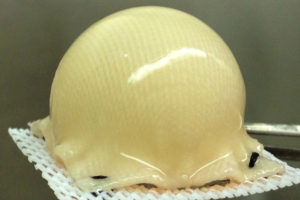Stem cells engineered to grow cartilage, fight inflammation
Technique uses 3-D weaving to grow a living hip replacement
 Robert Boston
Robert BostonWashington University biomedical engineering PhD student Ali Ross and Farshid Guilak, PhD, a professor of orthopedic surgery, show a container with a prototype of a living hip replacement. The scientists have coaxed stem cells to grow into new cartilage on a 3-D template shaped like the ball of a hip joint.

With a goal of treating worn, arthritic hips without extensive surgery to replace them, scientists have programmed stem cells to grow new cartilage on a 3-D template shaped like the ball of a hip joint. What’s more, using gene therapy, they have activated the new cartilage to release anti-inflammatory molecules to fend off a return of arthritis.
The technique, demonstrated in a collaborative effort between Washington University School of Medicine in St. Louis and Cytex Therapeutics Inc. in Durham, N.C., is described July 18 in Proceedings of the National Academy of Sciences.
The discovery one day may provide an alternative to hip-replacement surgery, particularly in younger patients. Doctors are reluctant to perform such operations in patients under age 50 because prosthetic joints typically last for less than 20 years. A second joint-replacement surgery to remove a worn prosthetic can destroy bone and put patients at risk for infection.
“Replacing a failed prosthetic joint is a difficult surgery,” said Farshid Guilak, PhD, a professor of orthopedic surgery at Washington University. “We’ve developed a way to resurface an arthritic joint using a patient’s own stem cells to grow new cartilage, combined with gene therapy to release anti-inflammatory molecules to keep arthritis at bay. Our hope is to prevent, or at least delay, a standard metal and plastic prosthetic joint replacement.”
The technique uses a 3-D, biodegradable synthetic scaffold that Guilak and his team developed. The scaffold, molded into the precise shape of a patient’s joint, is covered with cartilage made from the patient’s own stem cells taken from fat beneath the skin. The scaffold then can be implanted onto the surface of an arthritic hip, for example. Resurfacing the hip joint with “living” tissue is designed to ease arthritis pain, and delay or even eliminate the need for joint-replacement surgery in some patients.
Additionally, by inserting a gene into the newly grown cartilage and activating it with a drug, the gene can orchestrate the release of anti-inflammatory molecules to fight a return of arthritis, which usually is what triggers such joint problems in the first place.
“When there is inflammation, we can give a patient a simple drug, which activates the gene we’ve implanted, to lower inflammation in the joint,” said Guilak, also a professor of developmental biology and of biomedical engineering. “We can stop giving the drug at any time, which turns off the gene.”
 Guilak laboratory
Guilak laboratoryThat gene therapy is important, he explained, because when levels of inflammatory molecules rise in a joint, the cartilage is destroyed and pain increases. By adding gene therapy to the stem cell and scaffold technique, Guilak and his colleagues believe it will be possible to coax patients’ joints to fend off arthritis and function better for a longer time.
The 3-D scaffold is built using a weaving pattern that gives the device the structure and properties of normal cartilage. Franklin Moutos, PhD, vice president of technology development at Cytex, explained that the unique structure is the result of approximately 600 biodegradable fiber bundles woven together to create a high-performance fabric that can function like normal cartilage.
“As evidence of this, the woven implants are strong enough to withstand loads up to 10 times a patient’s body weight, which is typically what our joints must bear when we exercise,” Moutos said.
Currently, there are about 30 million Americans who have diagnoses of osteoarthritis, and data suggest that the incidence of osteoarthritis is on the rise. That number includes many younger patients — ages 40 to 65 — who have limited treatment options because conservative approaches haven’t worked and they are not yet candidates for total joint replacement because of their ages.
Bradley Estes, PhD, vice president of research and development at Cytex, noted, “We envision in the future that this population of younger patients may be ideal candidates for this type of biological joint replacement.”
Guilak, who also is the director of research at Shriners Hospitals for Children — St. Louis, and co-director of the Washington University Center of Regenerative Medicine, has been collaborating with Cytex on this research. The scientists have tested various aspects of the tissue engineering in cell culture, and some customized implants already are being tested in laboratory animals. He said if all goes well, such devices could be ready for safety testing in humans in three to five years.






